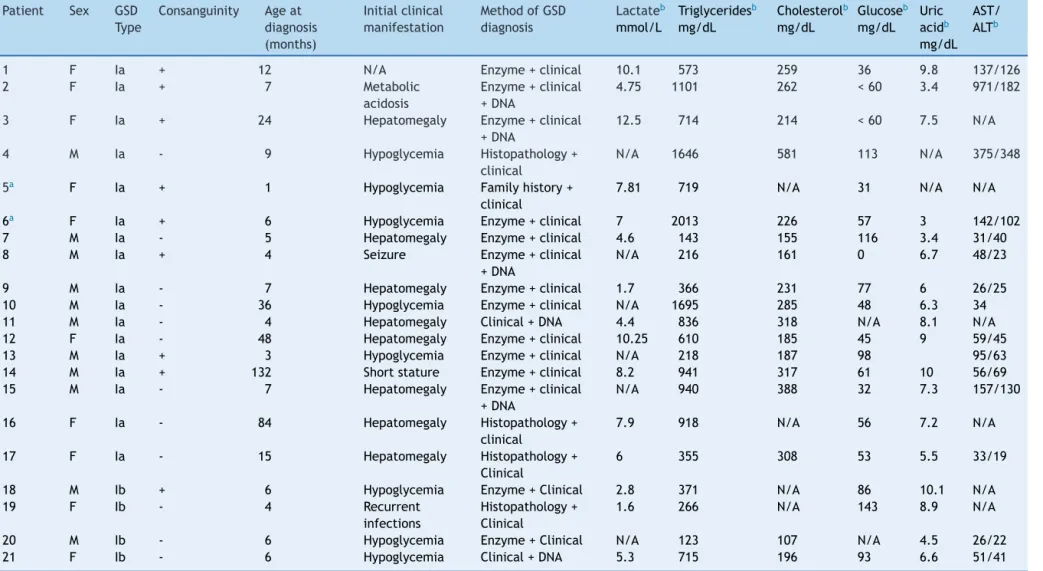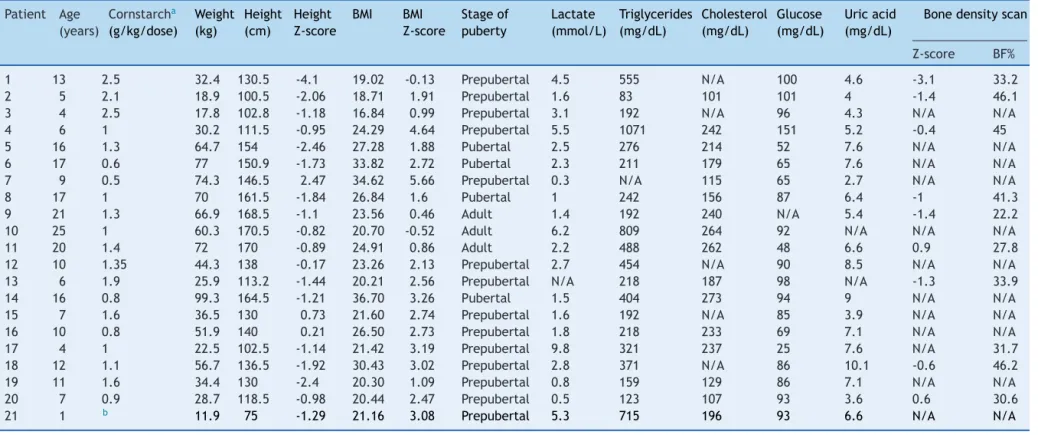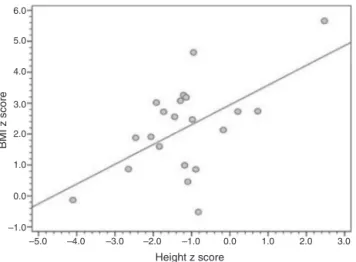JPediatr(RioJ).2014;90(6):572---579
www.jped.com.br
ORIGINAL
ARTICLE
Glycogen
storage
disease
type
I:
clinical
and
laboratory
profile
夽
,
夽夽
Berenice
L.
Santos
a,
Carolina
F.M.
de
Souza
b,
Lavinia
Schuler-Faccini
a,b,c,
Lilia
Refosco
b,
Matias
Epifanio
d,e,
Tatiele
Nalin
f,
Sandra
M.G.
Vieira
g,h,
Ida
V.D.
Schwartz
b,c,∗aPost-GraduatePrograminChildandAdolescentHealth,UniversidadeFederaldoRioGrandedoSul(UFRGS),PortoAlegre,RS,
Brazil
bMedicalGeneticsService,HospitaldeClínicasdePortoAlegre,PortoAlegre,RS,Brazil
cDepartmentofGenetics,UniversidadeFederaldoRioGrandedoSul(UFRGS),PortoAlegre,RS,Brazil dPontifíciaUniversidadeCatólicadoRioGrandedoSul(PUC-RS),PortoAlegre,RS,Brazil
eHospitalSãoLucas,PortoAlegre,RS,Brazil
fPost-GraduatePrograminGeneticsandMolecularBiology,UniversidadeFederaldoRioGrandedoSul(UFRGS),PortoAlegre,
RS,Brazil
gMedicalPediatricService,HospitaldeClínicasdePortoAlegre,PortoAlegre,RS,Brazil
hPost-GraduatePrograminGastroenterologyScienceandHepatology,UniversidadeFederaldoRioGrandedoSul(UFRGS),Porto
Alegre,RS,Brazil
Received15April2013;accepted28February2014 Availableonline11July2014
KEYWORDS
Inbornerrorsof metabolism; Glycogenstorage diseasetypeI; Clinicalaspects; Diagnoses; Nutritionalstatus
Abstract
Objectives: Tocharacterizetheclinical,laboratory,andanthropometricprofileofasampleof BrazilianpatientswithglycogenstoragediseasetypeImanagedatanoutpatientreferralclinic forinbornerrorsofmetabolism.
Methods: Thiswasacross-sectionaloutpatientstudybasedonaconveniencesamplingstrategy. Dataondiagnosis,management,anthropometricparameters,andfollow-upwereassessed.
Results: Twenty-onepatientswereincluded(medianage10years,range1---25years),allusing uncookedcornstarchtherapy.Medianageatdiagnosiswas7months(range,1---132months), and19patientsunderwentliverbiopsyfordiagnosticconfirmation.Overweight,shortstature, hepatomegaly,andliver noduleswerepresentin16 of21,fourof21,nine of14,andthree of14patients,respectively.Acorrelationwasfoundbetweenheight-for-ageandBMI-for-age Z-scores(r=0.561;p=0.008).
夽 Pleasecitethisarticleas:SantosBL,deSouzaCF,Schuler-FacciniL,RefoscoL,EpifanioM,NalinT,etal.Glycogenstoragediseasetype
I:clinicalandlaboratoryprofile.JPediatr(RioJ).2014;90:572---9.
夽夽
StudyconductedattheUniversidadeFederaldoRioGrandedoSul,HospitaldeClínicasdePortoAlegre,PortoAlegre,RS,Brazil.
∗Correspondingauthor.
E-mail:ischwartz@hcpa.ufrgs.br(I.V.D.Schwartz).
http://dx.doi.org/10.1016/j.jped.2014.02.005
GlycogenstoragediseasetypeI 573
Conclusions: Diagnosis ofglycogenstoragedisease typeIisdelayedinBrazil.Mostpatients undergoliverbiopsyfordiagnosticconfirmation,eventhoughthecombinationofa character-isticclinicalpresentationandmolecularmethodscanprovideadefinitivediagnosisinaless invasivemanner.Obesityisasideeffectofcornstarchtherapy,andappearstobeassociated withgrowthinthesepatients.
©2014SociedadeBrasileiradePediatria.PublishedbyElsevierEditoraLtda.Allrightsreserved.
PALAVRAS-CHAVE
Errosinatosdo metabolismo; Doenc¸adedepósito deglicogêniotipoI; Aspectosclínicos; Diagnósticos; Estadonutricional
Doenc¸adedepósitodeglicogêniotipoI:perfilclínicoelaboratorial
Resumo
Objetivos: Caracterizar o perfil clínico, laboratorial e antropométrico de uma amostra de pacientesbrasileiroscomdoenc¸adedepósitodeglicogêniotipoItratadosemumambulatório dereferênciaparaerrosinatosdometabolismo.
Métodos: Este foi um estudo ambulatorial transversal com base em uma estratégia de amostragem deconveniência. Foramavaliadososdados comrelac¸ão ao diagnóstico, trata-mento,parâmetrosantropométricoseacompanhamento.
Resultados: Foramincluídos21pacientes(idademédiade10anos,faixa1-25anosdeidade), etodosseencontravamemterapiadeamidodemilhocru.Aidademédianaépocado diagnós-ticofoidesetemeses(faixa,1-32meses),e19pacientesforamsubmetidosabiópsiahepática paraconfirmac¸ãododiagnóstico.Sobrepeso,baixaestatura,hepatomegaliaenódulos hepáti-cos foramfatorespresentesem 16de21,quatrode21,novede14etrêsde14pacientes, respectivamente.Foiencontradaumacorrelac¸ãoentreosescoreszparapesoparaidadeeIMC paraidade(r=0,561;p=0,008).
Conclusões: Odiagnósticodadoenc¸adedepósitodeglicogêniotipoItemsidotardionoBrasil. Amaioriadospacientesfoisubmetidaaconfirmac¸ãododiagnóstico,apesardeoquadroclínico característicoeosmétodosmolecularespoderemfornecerumdiagnósticodefinitivodeforma menosinvasiva.Obesidadeéumefeitocolateraldaterapiacomamidodemilhoepareceestar associadaacrescimentonessespacientes.
©2014SociedadeBrasileiradePediatria.PublicadoporElsevierEditoraLtda.Todososdireitos reservados.
Introduction
Glycogen storage disease type I (GSDI, or von Gierke’s disease) is caused by deficiency of glucose-6-phosphatase (G6Pase),anenzymethatcatalyzeshydrolysisof glucose-6-phosphate(G6P)intoglucoseandinorganicphosphate(Pi), akeystepinthemaintenanceofglucosehomeostasis.Two majorsubtypesofGSDIarerecognized:GSDtypeIa(GSDIa), whichistheresultofamutationaffectingthecatalytic sub-unitof G6Pase-alpha(or G6PC),andGSD typeIb (GSDIb), whichiscausedbyadefectinG6Ptranslocase(orG6PT).1
GSDIisinheritedinanautosomalrecessivepattern,andits incidenceisestimatedatonein100,000livebirths,making itthemostcommonofthehepaticGSDs.2
PatientswithGSDIapresentwithhepatomegaly,a char-acteristic ‘‘doll-like’’ face, short stature, and chronic fatigue. Laboratory findings suggestive of GSDIa include hypoglycemiaafterafourtosixhourfast,lacticacidosis, hypertriglyceridemia,and hyperuricemia. Functional tests fordifferentialdiagnosis ofhypoglycemiashowabsenceof glycemic response to glucagon injection and aggravation of hyperlactacidemia,3 whereas histopathological analysis
ofhepaticbiopsyspecimensshowsglycogenbuildupinthe liver.InGSDIb,theclinicalpresentationisquite similarto that of GSDIa, but may be accompanied by neutropenia
withrecurrentinfections(particularlyofthe gastrointesti-naltract)andanincreasedincidenceofinflammatorybowel disease.4Althoughthegold-standardmethodsfordiagnosis
ofGSDIaarethemeasurementofG6PCorG6PTactivityin livertissueand/ordetectionofpathogenicmutationsinthe genesthatcodeforG6PCandG6PT,specifictherapycanbe initiatedbasedsolelyontheclinicalandhistopathological findings.3 Access totheDNA/enzymetestsis limitedsince
theyareonlyprovidedbyaselectfewnationaland inter-nationalcenters,usuallywithintheframeworkofresearch projects.
Management of GSDI is essentially dietary,3 and
574 SantosBLetal.
nephrocalcinosis, hepatocellular adenomas (with poten-tial for malignant transformation),pancreatitis secondary to hypertriglyceridemia, and potentially life-threatening hypoglycemia.5,6
The objective of this study was to assess the clinical andlaboratoryprofileofasampleofBrazilianpatientswith GSDIrecruitedfromanoutpatientreferralcenterforinborn errorsofmetabolism.Themainresearchhypothesiswasthat diagnosisofGSDIisdelayedinBrazil,bothduetoalackof accesstodiagnosticmethodsandduetopoorawarenessof theconditionbyhealthcareproviders,thushinderingearly accesstospecifictreatmentandgeneticcounseling.
Methods
ThisstudywasapprovedbytheEthicsCommitteeofHospital deClínicasdePortoAlegre(HCPA,Brazil).Allsubjectssigned aninformedconsentpriortostudyparticipation.
This was an outpatient-based case series with cross-sectionalanalysisofthevariablesofinterest.Aconvenience sampling strategy was used. The study was conducted between March of 2011 and January of 2013. The cri-terion for inclusion was a diagnosis of GSDI established using at least two of the following methods (the diag-nosis was independently confirmed by the authors in all patients): a) clinical diagnosis, defined by over 12 monthsof specialist care (led by hepatologist or medical geneticist)andclinicalmanifestationsconsistentwithGSDI (hypoglycemiawithhyperlactatemia,hypertriglyceridemia, hyperuricemia, hepatomegaly, and/or growth failure and short stature, and normal levels of creatine phosphoki-nase [CPK]) at the time of diagnosis or at the time of study inclusion; b) positive familyhistory consistent with autosomalrecessiveinheritance,aslongasGSDIhadbeen confirmed by enzymatic methods or DNA analysis in the affectedrelative(s);c)histopathologicaldiagnosis,defined asthepresenceofhistologicalchangesinlivertissue con-sistent withGSD, such ashyperglycogenated nuclei, mild fibrosis,andfattychangeswithlipidvacuoles;7d)enzymatic
diagnosis,definedbynegligibleactivity(<10%)ofG6Pasein freshorfrozenlivertissuesamples;ore)molecular diagno-sis,definedbythepresenceofpathogenicmutationsinthe
G6PCgene(forpatientswithGSDIa)orintheSLC37A3gene
(forthosewithGSDIb)asdetectedbymolecularmethods. ThedistinctionbetweenGSDIaandGSDIbwasmostlybased on clinical findings (absence or presence of neutropenia, respectively),asmoleculardiagnosticswereunavailableto themajorityofpatients.
Patientswereinvitedtotakepartinthestudyafter rou-tinevisits.Thosewhoagreedtoparticipatewereallassessed bythesameresearcherandunderwentatargetedhistory, physicalexamination,andanthropometricassessment.The latestlaboratoryvalues(bloodglucose,lactate,cholesterol, triglycerides,uric acid)and imagingfindings available for each patient were obtained by means of a chartreview. Testsperformeduptothreemonthspriorto anthropomet-ricassessmentwereconsideredacceptable.Thevariablesof interestweresex,parentalconsanguinity,currentage,age atdiagnosis(definedastheageatwhichparentsreporteda specificdiagnosisofGSDor,ifunavailable,theageat diagno-sisasnotedinthepatient’sfirstchartcontainingdiagnostic
testresultsandstartofdietarymanagement),firstclinical manifestation (asreportedbyparents),laboratory param-eters (current and at time of diagnosis), liver biopsy for histopathological examination or molecular analysis, and current clinical and imagingdata (anthropometric assess-ment,liverultrasound,andbonemineraldensityandbody compositionbydual-energyX-rayabsorptiometry[DEXA]).
Anthropometricassessmentconsistedofweight(kg)and height(cm)measurement.Bodyweightwasmeasuredusing digitalscaleswithamaximumcapacityof150kganda reso-lutionof100g,certifiedbytheBrazilianNationalInstituteof Metrology,Standardization,andIndustrialQuality(Instituto NacionaldeMetrologia,QualidadeeTecnologia-INMETRO). Patientswereweighedwhilenudeandbarefoot.Heightwas measuredwithawall-mountedstadiometerpreciseto1mm. Inadolescents,theTannerscalewasusedforpubertal stag-ing. Anthropometric measurements and classifications for age and sexwere calculated in the World Health Organi-zation’sAnthroPlussoftwaresuite.Thevariablesofinterest wereheight-for-ageandBMI-for-ageZ-scores,asproposed bytheBrazilianSocietyofPediatrics.8
Liversizewasmeasuredbyultrasonographyandassessed fornormalityonthebasisofthereferencesizesforchildren publishedin2010byDhingraetal.9Whenobjectivedataon
liver size weremissing, the sonographer’simpression was usedinstead(normalorenlarged).
The criteria for adequacy of metabolic control were basedontheEuropeanStudyonGlycogenStorageDisease Type 1 (ESGSD I):5 blood glucose > 63mg/dL,
triglyceri-des<530mg/dL,uricacid<7mg/dL,BMIbetween0and+2 standard deviations (SD), and lactate > 2.5 mmol/L (the latterusedastheurinelactate/creatinineratiowas unavail-able). The absence of hepatic adenomas and adequate height-for-age (z-score> -2SD)areimportantparameters forassessment ofmetaboliccontroladequacy,butarenot partoftheESGSDI.5
Statistical analyses were conducted in the Statistical Package for the Social Sciences® version 20.0 (SPSS Inc., Chicago,IL, USA).Continuousvariableswereexpressedas meansandstandarddeviationsorasmediansand interquar-tile ranges. Analysis of variance (ANOVA) was used for comparisonofheightandBMIz-scores.Thesignificancelevel wassetat5%.DatawereenteredintoaMicrosoftExcel2010 for Windows spreadsheet (Microsoft, Redmond, WA, EUA) andanalyzedinSPSS20.0(IBMCorp.,Armonk,NY,USA).
Results
Twenty-one patients were included in the study: 17 with GSDIaandfourwithGSDIb.Table1showsthesampleprofile atthetimeofdiagnosis.
Glycogen
storage
disease
type
I
575
Table1 Summaryoffindingsatdiagnosisamongpatientswithglycogenstoragedisorder(GSD)typeI(n=21).
Patient Sex GSD Type
Consanguinity Ageat diagnosis (months)
Initialclinical manifestation
MethodofGSD diagnosis
Lactateb
mmol/L
Triglyceridesb
mg/dL
Cholesterolb
mg/dL
Glucoseb
mg/dL Uric acidb
mg/dL AST/ ALTb
1 F Ia + 12 N/A Enzyme+clinical 10.1 573 259 36 9.8 137/126
2 F Ia + 7 Metabolic
acidosis
Enzyme+clinical +DNA
4.75 1101 262 <60 3.4 971/182
3 F Ia + 24 Hepatomegaly Enzyme+clinical
+DNA
12.5 714 214 <60 7.5 N/A
4 M Ia - 9 Hypoglycemia Histopathology+
clinical
N/A 1646 581 113 N/A 375/348
5a F Ia + 1 Hypoglycemia Familyhistory+
clinical
7.81 719 N/A 31 N/A N/A
6a F Ia + 6 Hypoglycemia Enzyme+clinical 7 2013 226 57 3 142/102
7 M Ia - 5 Hepatomegaly Enzyme+clinical 4.6 143 155 116 3.4 31/40
8 M Ia + 4 Seizure Enzyme+clinical
+DNA
N/A 216 161 0 6.7 48/23
9 M Ia - 7 Hepatomegaly Enzyme+clinical 1.7 366 231 77 6 26/25
10 M Ia - 36 Hypoglycemia Enzyme+clinical N/A 1695 285 48 6.3 34
11 M Ia - 4 Hepatomegaly Clinical+DNA 4.4 836 318 N/A 8.1 N/A
12 F Ia - 48 Hepatomegaly Enzyme+clinical 10.25 610 185 45 9 59/45
13 M Ia + 3 Hypoglycemia Enzyme+clinical N/A 218 187 98 95/63
14 M Ia + 132 Shortstature Enzyme+clinical 8.2 941 317 61 10 56/69
15 M Ia - 7 Hepatomegaly Enzyme+clinical
+DNA
N/A 940 388 32 7.3 157/130
16 F Ia - 84 Hepatomegaly Histopathology+
clinical
7.9 918 N/A 56 7.2 N/A
17 F Ia - 15 Hepatomegaly Histopathology+
Clinical
6 355 308 53 5.5 33/19
18 M Ib + 6 Hypoglycemia Enzyme+Clinical 2.8 371 N/A 86 10.1 N/A
19 F Ib - 4 Recurrent
infections
Histopathology+ Clinical
1.6 266 N/A 143 8.9 N/A
20 M Ib - 6 Hypoglycemia Enzyme+Clinical N/A 123 107 N/A 4.5 26/22
21 F Ib - 6 Hypoglycemia Clinical+DNA 5.3 715 196 93 6.6 51/41
Allpatientshadclinicalmanifestationsatthetimeofdiagnosisorwereintreatmentwithapediatricgastroenterologistormedicalgeneticistatthetimeofstudyinclusionandhad
histopathologicalevidenceofhepaticglycogenbuildupand/orG6Paseactivityat<10%inlivertissueand/orpresenceofpathogenicmutationsintheG6Pasegene,andabsenceofhigh
levelsofcreatinephosphokinase.
AST,aspartateaminotransferase;ALT,alanineaminotransferase.
a Patients5and6formaSibship;patient6istheoldersibling.
b Valuesatdiagnosis;+,present;-,absent;N/A,notavailable.Referenceranges:lactate,0.5---2.2mmol/L;triglycerides, 100mg/dLatage<10years,≤130mg/dLatage10---19,
576
Santos
BL
et
al.
Table2 LastanthropometricandlaboratoryassessmentofpatientswithglycogenstoragedisordertypeI(n=21).
Patient Age (years)
Cornstarcha
(g/kg/dose)
Weight (kg)
Height (cm)
Height Z-score
BMI BMI
Z-score
Stageof puberty
Lactate (mmol/L)
Triglycerides (mg/dL)
Cholesterol (mg/dL)
Glucose (mg/dL)
Uricacid (mg/dL)
Bonedensityscan
Z-score BF%
1 13 2.5 32.4 130.5 -4.1 19.02 -0.13 Prepubertal 4.5 555 N/A 100 4.6 -3.1 33.2
2 5 2.1 18.9 100.5 -2.06 18.71 1.91 Prepubertal 1.6 83 101 101 4 -1.4 46.1
3 4 2.5 17.8 102.8 -1.18 16.84 0.99 Prepubertal 3.1 192 N/A 96 4.3 N/A N/A
4 6 1 30.2 111.5 -0.95 24.29 4.64 Prepubertal 5.5 1071 242 151 5.2 -0.4 45
5 16 1.3 64.7 154 -2.46 27.28 1.88 Pubertal 2.5 276 214 52 7.6 N/A N/A
6 17 0.6 77 150.9 -1.73 33.82 2.72 Pubertal 2.3 211 179 65 7.6 N/A N/A
7 9 0.5 74.3 146.5 2.47 34.62 5.66 Prepubertal 0.3 N/A 115 65 2.7 N/A N/A
8 17 1 70 161.5 -1.84 26.84 1.6 Pubertal 1 242 156 87 6.4 -1 41.3
9 21 1.3 66.9 168.5 -1.1 23.56 0.46 Adult 1.4 192 240 N/A 5.4 -1.4 22.2
10 25 1 60.3 170.5 -0.82 20.70 -0.52 Adult 6.2 809 264 92 N/A N/A N/A
11 20 1.4 72 170 -0.89 24.91 0.86 Adult 2.2 488 262 48 6.6 0.9 27.8
12 10 1.35 44.3 138 -0.17 23.26 2.13 Prepubertal 2.7 454 N/A 90 8.5 N/A N/A
13 6 1.9 25.9 113.2 -1.44 20.21 2.56 Prepubertal N/A 218 187 98 N/A -1.3 33.9
14 16 0.8 99.3 164.5 -1.21 36.70 3.26 Pubertal 1.5 404 273 94 9 N/A N/A
15 7 1.6 36.5 130 0.73 21.60 2.74 Prepubertal 1.6 192 N/A 85 3.9 N/A N/A
16 10 0.8 51.9 140 0.21 26.50 2.73 Prepubertal 1.8 218 233 69 7.1 N/A N/A
17 4 1 22.5 102.5 -1.14 21.42 3.19 Prepubertal 9.8 321 237 25 7.6 N/A 31.7
18 12 1.1 56.7 136.5 -1.92 30.43 3.02 Prepubertal 2.8 371 N/A 86 10.1 -0.6 46.2
19 11 1.6 34.4 130 -2.4 20.30 1.09 Prepubertal 0.8 159 129 86 7.1 N/A N/A
20 7 0.9 28.7 118.5 -0.98 20.44 2.47 Prepubertal 0.5 123 107 93 3.6 0.6 30.6
21 1 b 11.9 75 -1.29 21.16 3.08 Prepubertal 5.3 715 196 93 6.6 N/A N/A
BMI,bodymassindex.
a Allpatientswereonuncookedstarchtherapy(fourtosixtimes/day)andnonewereoncontinuousnocturnalglucoseinfusion.
b Patientwhoreceivedcornstarchirregularly.
Height-for-ageandBMI-for-ageZ-scorescalculatedinWorldHealthOrganization’sAnthroandAnthroPlus.BonedensityscanningperformedinaLunariDXA(GEHealthcare)device.Bone
mineraldensityZ-scorescalculatedandbodycompositionexpressedasbodyfatpercentage(BF%).BonemineraldensityZ-scoresnotcalculatedforpatient17duetoage<5years.N/A,
notavailable.
Referenceranges:lactate,0.5---2.2mmol/L;triglycerides,≤100mg/dLatage<10years,≤130mg/dLatage10---19,≤150mg/dLinadults;totalcholesterol,<129mg/dL;glucose,
GlycogenstoragediseasetypeI 577
6.0
5.0
4.0
3.0
2.0
1.0
–1.0
–5.0 –4.0 –3.0 –2.0 –1.0 0.0
Height z score
BMI z score
1.0 2.0 3.0 0.0
Figure1 CorrelationbetweenBMI-for-ageandheight-for-age Z-scores(r=0.561;p=0.008).
BMI,bodymassindex.
Body composition was analyzed in ten patients (eight withGSDIa, twowithGSDIb) (Table 2).Fourteen patients underwent abdominal ultrasonography for assessment of liversize;ofthese,fivehadanormalliversize,oneofwhom hadavisiblehepaticnodule.Theeightremainingpatients hadhepatomegaly,andtwohadmorethanthreedetectable nodules.
Discussion
Thecharacterizationofthenaturalhistoryofrarediseases and of the efficacy of treatments for these conditions is always hindered by smallsample sizes.10 The small
num-berofpatientsisattributablenotonlytotherarityofthese diseases, but alsotounderdiagnosis, particularly of cases withrelativelymildclinicalmanifestations.Therefore, stud-ies such as the present --- the first-ever characterization of a population ofGSDI patientsin Brazil areparamount, giventheircrucialroleinenablinglaterconductionof meta-analysisandthedrawingofmorerobustconclusions.
DiagnosisofGSDIwasdelayedinthissample,confirming theinitialhypothesis.Accordingtotheliterature,theusual ageofsymptomonsetinpatientswithGSDIis3months.4This
studydidnotassessthevariable‘‘ageatsymptomonset’’ astheauthorsbelieveittobesubjecttoa widerangeof biases,particularlyrecallbias.Studieshaveshownthat ear-lierdiagnosisandtreatmentonsetareassociatedwithlower odds of complications.3 In the present sample, the
earli-estclinical diagnosiswasestablishedin apatient(patient 5)whodevelopedsymptoms beforethe 1stmonthof life, whohadan oldersister(patient6)withaconfirmed diag-nosis ofGSDIa.The latest diagnosis wasat 132monthsof age, inpatient 14,whohad subclinicalhypoglycemia and was diagnosed after a three year investigation prompted byshortstature,thusrepresentingasomewhatattenuated phenotypeofthecondition.Althoughhypoglycemiaisoneof thecardinalsymptomsthatdriveclinicalsuspicionofGSDI, it may sometimes go unnoticed due touse of lactic acid asasubstratefor cerebral metabolism.11 Therefore,even
though symptomatic hypoglycemia isfrequently reported, itsabsencedoesnotruleoutadiagnosisofGSDI. In2003,
Shiehetal.publishedacasereportdescribingdelayed diag-nosis of GSDI and suggested that ‘‘milder’’ forms of the conditionmayoccur.11Alsoin2003,anarticlerecommended
thatadolescentswithunexplainedhyperuricemiaand hyper-lipidemiashouldbescreenedforGSDI,evenifhypoglycemia wasabsent.12
Regarding diagnostic procedures, most patients in the present sample underwent aliver biopsy.13 This findingis
rathersurprisinginviewoftheincreasedworldwide acces-sibilityofgenetictesting.TheG6PCgeneissmall(12.5kb,5 exons)andthuseasilysequenced;furthermore,thevariants p.347X and p.R83C appear to be common in the Brazil-ian population, as reported by Reis et al. in 2011.14 In
the present sample, these mutations were found in four often and threeof ten patients withGSDIa,respectively (datanotshown).Althoughitisnotentirelydevoidofrisk, bloodcollectionforgeneticassaysisafarlessinvasiveand lesscostlyprocedurethanliverbiopsyforhistopathological examination or enzyme activity assessment. Isolated his-tological analysis of liver tissue without measurement of enzymeactivity isnotsufficient todetermine thetypeof GSD,althoughitcandemonstrateglycogenandfat deposi-tion,andis valuablein thedifferentialdiagnosis of other liverdiseases.Conversely,enzymeassaysareavailableonly at very few centers and are associated with a series of logistical challenges, such as tissue transport (specimens should preferably be fresh or frozen) to the reference laboratory.
The present datasuggest atrendtoward patients with higher height-for-age Z-scores having higher BMI-for-age Z-scoresaswell.15Althoughthistrendwasaffectedby
out-liers,itsuggeststhat intensivedietary managementleads tobettergrowthattheexpenseofmarkedweightgain,as previously reported by Weinstein and Wolfsdorf in 2002.6
Managementofobesity inpatientswithGSDIiscertainlya topicdeservingofgreaterresearchattention.
Growthretardation is afindingof majorimportancein childrenwithGSDI,16andshortstatureiscommoninadults
withthe condition. In the present sample, patients with inadequatemetaboliccontrolaccordingtotheESGSDI4had
theworst height-for-age Z-scores.The pathophysiologyof shortstatureinGSDIhasyettobeelucidated,butstudies conductedsince2008haveshownthatgoodmetabolic con-trolcanimprovegrowth.17,18Hormonalchanges,variationin
bloodpH(duetometabolicacidosis),andhyperlactatemia may contribute to this growth deficit. According to the ESGSDIcriteria,5halfofallpatientsinthepresentsample
hadgoodmetaboliccontroloftheircondition,eventhough somehadBMIZ-scores>2SDs,whichmayaccountatleast inpartforthenear-adequategrowthofthispopulation(18 of21patientshadheight-for-ageZ-scores>-2SDs).
578 SantosBLetal.
severalstudiesof UCCS(diurnalandnocturnal) with stud-ies of CNGDF, and found both short-term and long-term improvementofmetaboliccontrolinpatientsgivenUCCS.19
Therefore,CNGDFshouldberestrictedtoselect cases,as the inconvenience of use of a feeding pump and the risk of severe hypoglycemia in case of abrupt discontinuation of feeding (e.g., due to a power outage or pump mal-function) do not outweigh the metabolic control benefits ofintermittentnight-timeUCCSadministration.Amodified cornstarchformulation(Glycosade®,Vitaflo,NestléHealth Nutrition,Vevey,Switzerland),whichgrantedtheFoodand DrugAdministration(FDA)approvalin2012,isanalternative thatmayallowpatientstosleepthroughthenight.20
The hepatomegalyobserved in patients withGSDImay be the result of glycogen deposition and fatty liver dis-easesecondary toincreased flow offree fatty acids from the adipose tissue tothe liver.21 Routineliver ultrasound
is a noninvasive diagnostic modality that can be used to assess long-term treatment success. As this study’s anal-ysis of ultrasound findings was based on a chart review, operatorvariabilityisaconcern.Thehistologyof hepatocel-lularadenomasinGSDIissimilartothatofadenomasseen inother conditions.Severalhypotheseshaveattemptedto explain the development of adenomatous changes, such asimbalances in glucagon-to-insulin ratio, cellular glyco-gen overload,and proto-oncogeneactivation.21 The three
patientswithhepaticadenomasin thepresentcase series were 16, 17, and 25 years old (patients 5, 6, and 10 respectively).Patients5and6hadpoormetaboliccontrol, withhyperuricemiaandhypoglycemiadespitelow triglyce-ridesandnear-normallactatelevels.Patient10,theoldest patientinthissample,alsohadinadequatemetabolic con-trol.
Hepatocellular adenomas may occur in 22% to 75% of adultswithGSDIa,andtheriskofmalignanttransformation isapproximately10%.21Asmostpatientsareundertheage
of20,alowincidenceofadenomasistobeexpectedinthis populationregardlessofmetaboliccontrol.Thusfar,there arenocasesofhepatocarcinomainthisseries.
Of the nine patients in whom bone density scans wereperformed, only one (patient1) hadlow bone mass for chronological age in accordance with the 2008 Offi-cial Position Statement of the Brazilian Society for Bone Densitometry.22Severalmechanismshavebeensuggestedto
explainthelow bonemineraldensity observedinpatients withGSDI:persistentacidosis,urinarycalciumlosswithout adequate replacement, reduction of bone matrix (hypo-glycemia leads todecreased glycosylation of bone matrix proteins), and changes in growth hormone (GH) levels.18
Furthermore, many patients with GSDI exhibit abnormal pubertalgrowth,5andsexsteroidsplayamajorroleinbone
formation,particularlyduringpuberty.22 Someissuesmust
betaken into account when analyzing bone mineral den-sityinchildrenandadolescents,suchasbonematuration, sex,andstageofpuberty.23Overall,thepatientsassessedin
thiscaseserieshadgoodbonemineraldensitydespitetheir GSDI.
DespitetherarityofGSDI,itmustnotbeoverlookedby pediatricians.Theagentusedfortreatment ofthisinborn errorofmetabolismisreadilyavailableatanygrocerystore orsupermarket.Administrationofcornstarchasa nutraceu-tical (food usedfor medicinal purposes) toGSDI patients
leadstoexcessiveweightgainasasideeffect,duetothe attendantincreasein totalcarbohydrateintakeand prob-ablydue torelativephysical inactivity aswell. Nostudies have assessedtheefficacyof physicalexercisein patients withGSDI,anditisnotcontraindicated.Therefore,physical activity---supportedbyawell-designeddietaryprescription thattakesthepre-andpost-exerciseperiodsintoaccount ---maybeaneffectivestrategyforthecontrolofweightgainin patientswhosemetaboliccontrolisotherwisesatisfactory.
Greaterawareness ofthisdisorderamongpediatricians shouldaidtheirsearchforanetiologicaldiagnosisincases of hypoglycemia, hepatomegaly, dyslipidemia, and short staturethatmightotherwisebeimproperlymanaged.Early diagnosisbasedonclinicalandlaboratoryfindingsis feasi-ble,easy,andaffordableevenwhereaccesstospecialtycare is limited. Nevertheless,investment in centersfor expert moleculardiagnosisisbothwarrantedandnecessary,asthe useofmolecularmethodspracticallyobviatestheneedfor liverbiopsy.Earlytreatmentcanbeinstitutedatanyhealth service, does not require any complexinterventions, and decreases the risk of death, mainly by preventing severe hypoglycemia.Adequatelytreatedpatientscanlead intel-lectually and socially satisfying lives with no limitations otherthanaspecialdiet.
Funding
FIPE-HCPA,FAPERGSandCNPq.
Conflicts
of
interest
Theauthorsdeclarenoconflictsofinterest.
Acknowledgements
ThisworkwassupportedbyFIPE-HCPA,FAPERGSandCNPq. Theauthorswouldliketothankthemultidisciplinaryteam attheInbornErrorsofMetabolismClinicsoftheHCPA Medi-calGenetics Service, theHCPA andPUC Gastroenterology andHepatologyServices,theSIEM,andAnaCarolina Mon-teiroforhelpingwiththemanuscriptandwiththediagnosis andassistanceofthepatients.Theauthorswouldalsoliketo thankDr.TerryDerksfortheinvaluablelearning opportuni-tiesprovided,andDr.DavidWeinsteinforhismanyteachings thatcontributeddirectly orindirectlytothisstudy,which mayyetbecomethedrivingforceforamulticenterresearch group.
References
1.KoeberlDD,KishnaniPS,BaliD,ChenYT.Emergingtherapies forglycogenstoragediseasetypeI.TrendsEndocrinolMetab. 2009;20:252---8.
2.Annabi B, Hiraiwa H, Mansfield BC, Lei KJ, Ubagai T, Poly-meropoulosMH,etal.Thegeneforglycogen-storagedisease type 1b maps to chromosome11q23. Am J Hum Genet. 1998;62:400---5.
GlycogenstoragediseasetypeI 579
4.YamaguchiT,IharaK,MatsumotoT,TsutsumiY,NomuraA,Ohga S,et al. Inflammatorybowel disease-like colitis in glycogen storagediseasetype1b.InflammBowelDis.2001;7:128---32.
5.RakeJP,VisserG,LabruneP,LeonardJV,UllrichK,SmitGP,etal. GuidelinesformanagementofglycogenstoragediseasetypeI ---EuropeanStudyonGlycogenStorageDiseaseTypeI(ESGSDI). EurJPediatr.2002;161:S112---9.
6.Weinstein DA, Wolfsdorf JI. Effect of continuous glucose therapy with uncooked cornstarch on the long-term clinical course of type 1a glycogen storage disease. Eur J Pediatr. 2002;161:S35---9.
7.Gö˘güs¸S, Koc¸ak N, Ciliv G, Karabulut E, Akc¸ören Z, Kale G, etal.HistologicfeaturesoftheliverintypeIaglycogenstorage disease:comparativestudybetweendifferentagegroupsand consecutivebiopsies.PediatrDevPathol.2002;5:299---304.
8.SociedadeBrasileirade Pediatria(SBP).Avaliac¸ãonutricional dacrianc¸aedoadolescente:manualdeorientac¸ão.SãoPaulo: DepartamentoCientíficodeNutrologia.SociedadeBrasileirade Pediatria;2009.
9.DhingraB,SharmaS,MishraD,KumariR,PandeyRM,Aggarwal S.Normalvaluesofliverandspleensizebyultrasonographyin Indianchildren.IndianPediatr.2010;47:487---92.
10.DerksTG,MartensDH,SentnerCP,vanRijnM,deBoerF,Smit GP,etal.DietarytreatmentofglycogenstoragediseasetypeIa: uncookedcornstarchand/orcontinuousnocturnalgastric drip-feeding?MolGenetMetab.2013;109:1---2.
11.ShiehJJ,PanCJ,MansfieldBC,ChouJY.Aglucose-6-phosphate hydrolase, widely expressed outside the liver, can explain age-dependentresolutionofhypoglycemiainglycogenstorage diseasetypeIa.JBiolChem.2003;278:47098---103.
12.ShiehJJ,LuYH,HuangSW,HuangYH,SunCH,ChiouHJ,etal. Misdiagnosisassteatohepatitisinafamilywithmildglycogen storagediseasetype1a.Gene.2012;509:154---7.
13.OvchinskyN,MoreiraRK,LefkowitchJH,LavineJE.Liverbiopsy inmodernclinicalpractice:apediatricpoint-of-view.AdvAnat Pathol.2012;19:250---62.
14.deC,ReisF,CaldasHC,NoratoDY,SchwartzIV, GiuglianiR, BurinMG,etal.GlycogenstoragediseasetypeIa:molecular studyinBrazilianpatients.JHumGenet.2001;46:146---9.
15.Freedman DS. Determination of body size measures and blood pressure levels among children. J Pediatr (Rio J). 2013;89:211---4.
16.Moses SW. Pathophysiology and dietary treatment of the glycogen storage diseases. J Pediatr Gastroenterol Nutr. 1990;11:155---74.
17.MosesSW.Historicalhighlightsandunsolvedproblemsin glyco-genstoragediseasetype1.EurJPediatr.2002;161:S2---9.
18.MelisD,PivonelloR,ParentiG,DellaCasaR,SalernoM,Balivo F,etal.Thegrowthhormone-insulin-likegrowthfactoraxisin glycogenstoragediseasetype1:evidenceofdifferentgrowth patternsandinsulin-likegrowthfactorlevelsinpatientswith glycogenstoragediseasetype1aand1b.JPediatr.2010;156, 663-670.e1.
19.ShahKK,O’DellSD.Effectofdietaryinterventionsinthe main-tenanceofnormoglycaemiainglycogenstorage diseasetype 1a:asystematicreviewandmeta-analysis.JHumNutrDiet. 2013;26:329---39.
20.CorreiaCE,BhattacharyaK,LeePJ,ShusterJJ,TheriaqueDW, ShankarMN,etal.Useofmodifiedcornstarchtherapytoextend fastinginglycogenstoragediseasetypesIaandIb.AmJClin Nutr.2008;88:1272---6.
21.BandsmaRH,SmitGP,KuipersF.Disturbedlipidmetabolismin glycogenstoragediseasetype1.EurJPediatr.2002;161:S65---9.
22.Lewiecki EM, Gordon CM, Baim S, Leonard MB, Bishop NJ, Bianchi ML, et al. International Society for Clinical Den-sitometry 2007 Adult and Pediatric Official Positions. Bone. 2008;43:1115---21.


